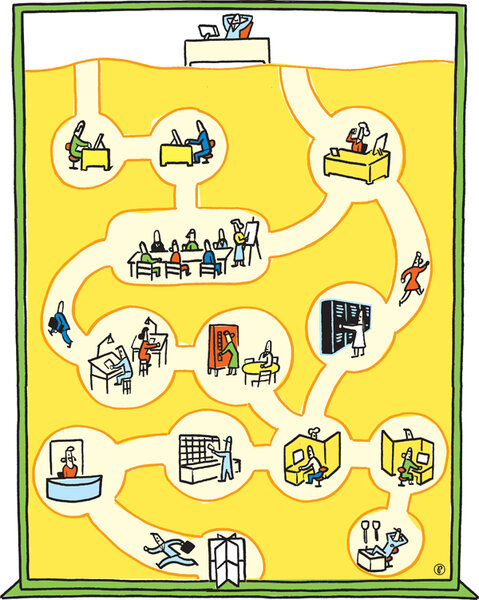The ‘living, breathing’ economy
Some time in mid-2008, mortgage defaults reached a critical mass. Wall Street went into free fall, and the US economy began to unravel. Then, like tumbling dominoes, economies around the world followed suit.
How could a few Americans defaulting on mortgages send the world economic system into a tailspin? There are probably as many answers as there are economists – maybe more. But for one school of economic thought, the more fundamental question is, why did almost no one see it coming? For these economists, the recent collapse reveals problems not just with the financial structure, but with how people conceive of and model the economy. A myopia pervades mainstream economic thinking, they charge. It fails to capture the dynamic – and somewhat chaotic – nature of what’s essentially a living system.
“We’re moving from looking at the economy in equilibrium to looking at the economy as a dynamic system that’s always changing,” says W. Brian Arthur, an external professor at the Santa Fe Institute in New Mexico. “It’s very much alive, ever-changing, and it’s never at equilibrium.”
Mr. Arthur envisions the economy as an ever-evolving ecosystem. With this as a starting assumption, it’s immediately clear that examining any part of this ecosystem in isolation, the reductionist approach that has dominated scientific inquiry since at least the Enlightenment – and which dominates economic theory now – will miss potentially game-changing interactions. That’s because self-organizing systems – the neurons that constitute your brain, the bees that make hives, and the humans that create markets – have what are called emergent properties. And it’s near impossible to predict these supremely important emergent behaviors by examining just the parts of the whole.
Consider the recent collapse. One version of its unfolding goes like this: After the dotcom boom and bust at the turn of the millennium, investors sought safe investments. Housing seemed to fit that bill. Builders got to building. Lenders lent to aspiring homeowners. Some offered the now-infamous subprime mortgages. These mortgages were bundled up – an innovation – and sold to third-party investors. Money was made at every level. That reinforced the cycle.
More houses went up, more brokers sold more loans, more mortgages were resold. Everyone made money – until the bubble popped. Then everyone began losing money.
“Everyone in that system was acting on perfectly rational decisions, even though the system as a whole was acting insane,” says John Miller, a professor of economics and social science at Carnegie Mellon University in Pittsburgh, Pa. “Everyone could follow the incentives, but those incentives led the system to an emergent behavior that was bad.”
The problem, say Mr. Miller and others, isn’t necessarily that this behavior emerged; it’s that mainstream economic models assume that economies always move toward equilibrium and can’t reproduce these bubbles. Our forecasting ability on this all-important aspect of real-world economies is, therefore, next to none.
In a recent essay in the journal Nature, scientists J. Doyne Farmer and Duncan Foley argue that world leaders are “flying the economy by the seat of their pants.” “Aren’t people on Wall Street using fancy mathematical models?” they write. “Yes, but for a completely different purpose: modelling the potential profit and risk of individual trades. There is no attempt to assemble the pieces and understand the behaviour of the whole economic system.”
One modeling approach succeeds in reproducing these bubbles quite well. So-called agent-based models – a simulation of a self-assembling system – tend to produce bubbles and wild swings as a matter of course, says Blake LeBaron, a professor at the International Business School at Brandeis University in Waltham, Mass.
“Across the agent-based financial models, one thing you definitely notice is the idea that crisis ... is sort of generic,” he says. “You have to work hard to get rid of these instabilities.”
Instability as a constant
In fact, instability may be an inescapable part of any complex, self-organizing system, he says. Ecologists note that ecosystems go through cycles of growing complexity, only to collapse, simplify, reorganize, and begin the cycle again.
Some ants illustrate another aspect of this principle. Army ants are famous for operating as if directed by an all-seeing intelligence when there is, in fact, no central command. They sweep through ecosystems and devour everything in their path – snakes, birds, even cows. They create living ant bridges to ford creeks, aggregate into balls that hang from trees, and carry out other seemingly top-down directed activities. They exemplify the magic of a self-organized system.
But sometimes, army ant foragers get caught in what’s known as a “circular mill.” After picking up their own trail of pheromones, they begin marching in a circle until they die of starvation.
Here’s the lesson: Self-organizing systems seem to be vulnerable to self-reinforcing cycles that lead to their own collapse. Because of how they interact – in this case, ants following pheromones and laying down more “follow me” pheromones along the way – the mistake of a few individuals can propagate, amplify, and bring down the whole structure.
Worker ants vs. free market
We are not ants, of course – although free markets do operate along the same principles. Unlike ants, we have the capacity to foresee and stave off “circular mill” situations, at least theoretically, through regulation. However, the anxiety, usually expressed by the political right, is that too much meddling will quash a self-organizing system’s exuberance. Let the system self-correct, they argue. Let the unfit die off, and the fit survive. We’ll be left with the strongest of all possibilities.
The counterargument, is that without guidance and occasional intervention – such as the $700 billion stimulus plan – market fluctuations can break the whole system. An ecosystem approach to economics supports this notion.
Arthur puts it this way: “The market does pretty well. It does pretty well like any other game, if there are set rules and a bunch of referees.”
Creating a resilient economic ecosystem
The recent collapse highlighted the extreme, and unprecedented, interconnectedness of modern financial institutions. “Before the crisis, people talked about ‘too big to fail,’ ” says Eric Beinhocker, author of “The Origin of Wealth.” “After the crisis, we talk about ‘too connected to fail.’ ”
While this interconnectedness enables efficiency and wealth creation, it also permits failure to spread more quickly than ever before, such as the ripples after people couldn’t pay their mortgages. If we accept that instability is an inherent quality of any self-organized system, one way to make economies more resilient is to sever some of that connectivity.
Miller uses the analogy of firebreaks in a forest. The gaps prevent conflagrations from consuming everything. In an economy, that means identifying the links – transparency, or knowing who owes what to whom – who can lend to whom. If one or two institutions fail, he says, the failure can’t spread.
Arthur has another idea: the financial equivalent of an environmental impact assessment. Financial innovations, such as derivatives, inevitably open up new ways to “game” the system, he says. Every innovation should therefore be assessed before implementation, its potential impact on the market “ecosystem” thought through by economists, and even Congress, in advance.
“If we had had that before,” he says, “we wouldn’t have gotten into this mess.”






